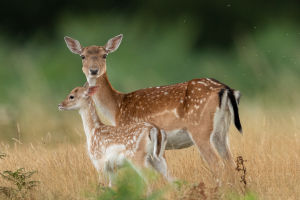
Chattering Charmers

In our day-to-day existence, parrots often assume the role of ambassadors for the avian world's vocal talents.
They possess the uncanny ability to mimic human speech and other auditory cues, a trait scarcely observed among their feathered counterparts.
Why do parrots possess this unique gift of gab while most other avians remain silent? This inquiry has piqued both curiosity and scholarly investigation.
To unravel the enigma of parrot speech, a comprehensive examination of their physiological attributes, habitat dynamics, and cognitive aptitude for behavioral acquisition is warranted.
First and foremost, the intricate physiological makeup of parrots lays the groundwork for their linguistic prowess. With a remarkably pliable tongue and vocal apparatus, parrots can articulate a diverse array of sounds.
Related
 How does a deer's life cycle reflect nature's wonders and the dance of life? Let's explore together!
How does a deer's life cycle reflect nature's wonders and the dance of life? Let's explore together!
 Do you know how owls became skilled rodent hunters? They achieved a perfect fusion of auditory and visual senses!
Do you know how owls became skilled rodent hunters? They achieved a perfect fusion of auditory and visual senses!
 Do you know why dolphins are so intelligent? Let's explore their brain, evolution, and habitat together!
Do you know why dolphins are so intelligent? Let's explore their brain, evolution, and habitat together!
 Do you know why cheetahs can run so fast? They're like powerful sports cars, standing at the top of the animal kingdom!
Do you know why cheetahs can run so fast? They're like powerful sports cars, standing at the top of the animal kingdom!
 What secrets do rabbits hold? Discover surprising truths in this enlightening exploration!
What secrets do rabbits hold? Discover surprising truths in this enlightening exploration!
 Why don't polar bears slip when walking on ice?
Why don't polar bears slip when walking on ice?
Their throat structure is notably more intricate than most avian species, allowing them to mimic human speech's nuanced tones and syllabic patterns.
Moreover, the cerebral architecture of parrots surpasses that of their avian counterparts, endowing them with superior learning and mimicking capabilities.
Furthermore, the habitat in which a parrot resides significantly influences its aptitude for speech. Many parrots inhabit tropical forest ecosystems with a cacophony of auditory stimuli and linguistic diversity.
Adapting to such environments necessitates the ability to discern and replicate an assortment of sounds, fostering the innate potential of parrots to acquire and emulate language.

Additionally, the sociability and intelligence inherent in parrots are pivotal in shaping their verbal communication ability. Parrots are inherently gregarious creatures, often congregating in flocks and engaging in vocal exchanges that include mimicry of other avian species and human speech.
Through interaction with humans, parrots assimilate the cadence and syntax of our language, laying the foundation for their vocalization.
The research underscores the remarkable cognitive faculties of parrots, enabling them to grasp and reproduce intricate linguistic structures with relative ease.
However, not all parrots possess the capacity for speech, with individual variances, environmental factors, and opportunities for linguistic acquisition playing decisive roles.
Some parrots may lack the innate aptitude for sound mimicry, while others may be deprived of exposure to language-learning stimuli. Consequently, even among conspecifics, disparities in speech capabilities may arise.
In summary, the phenomenon of parrot speech is an amalgamation of diverse factors encompassing their specialized physiological attributes, habitat dynamics, sociability, and cognitive prowess.
The ability of parrots to vocalize not only captivates our imagination but also enriches the tapestry of interspecies communication, fostering moments of wonder and delight.
Thus, delving into the intricacies of parrot speech promises not only to deepen our understanding of these remarkable creatures but also to broaden our insights into language acquisition and animal behavior.